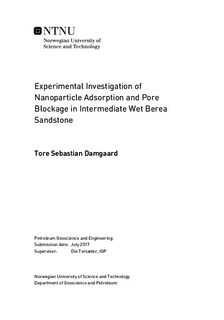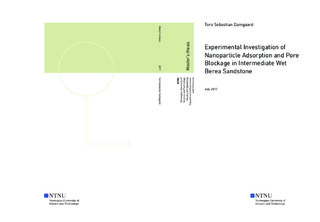| dc.description.abstract | The global demand of energy is increasing with the growing population, and an increased consumption of available resources is therefore required. Even though there has been more focus on renewable energy over the last years, oil is still the main source of energy worldwide (IEA and OECD, 2016). Thus, continued oil extraction is necessary to satisfy the growing energy demand until it can be replaced by renewable alternatives. Since oil is non-renewable, the production must be maintained by either discovering new hydrocarbonreservoirs,orbyimprovingtheoilrecoveryinthereservoirs. Conventionalproduction methods are seldom capable of producing more than 40 % of the reservoir oil (Schlumberger, 1998d), which means that there is a large potential for enhanced the oil recovery (EOR).
The use of nanotechnology is beneficial in a range of fields, and its applications have also been suggested for the upstream sector of the petroleum industry (Lau et al., 2016). Silica (SiO2) nanoparticles have proved to be efficient for EOR in a range of laboratory core floods (Hendraningrat et al., 2012; Li et al., 2013; Ogolo et al., 2012; El-Diasty, 2015),and a combination of rock wettability alteration and reduction of interfacial tension (IFT) between oil and water are believed to be the main oil displacement mechanisms. Since silica nanoparticles consist of 99.8% SiO2 (Evonik, 2015), which is the main mineral in sandstone, they are are also considered environmentally friendly. This solves the legality issues related to field injection of EOR formulations in countries with a strong environmental policy. However, silica nanoparticles are easily destabilized when they are dispersed in saltwater and exposed to high temperature, which are regular sub-surface conditions.
In this master s thesis, I have looked at the EOR potential of nanofluids and the technical feasibility of field implementations. Laboratory experiments have been conducted to investigate the propagation of silica nanoparticles at various conditions, as this is important for the feasibility of field implementations. The nanoparticles were injected in intermediate wet Berea sandstone cores, since these were believed to represent many of the world s oil saturated sandstone reservoirs(Cosentino, 2001). Nanoparticle retention during transportation through the cores was studied, and a simple stabilizer was demonstrated to counter spontaneous nanoparticle aggregation at reservoir conditions. The results from the laboratory experiments showed that the formation damage from regular nanofluid injection is severe and almost makes the rocks impermeable. The formation damage was reduced when stabilizer was added to the nanofluids, but the improvement was too small for a field implementation of the EOR method. In order to study nanoparticle propagation at reservoir conditions, the flow rate was lowered and the temperature was elevated. This resulted in increased nanoparticle retention, and complete pore blockage after only 2 PVs of injection. This emphasizes the need for methods to stabilize nanosilica suspensions at reservoir conditions. | |

